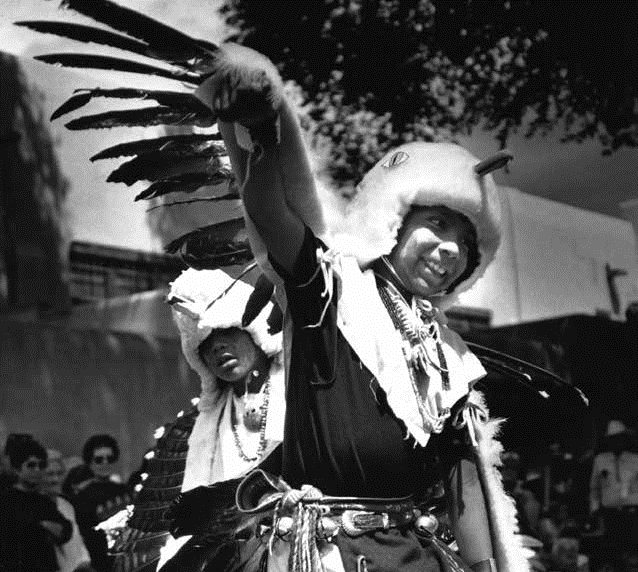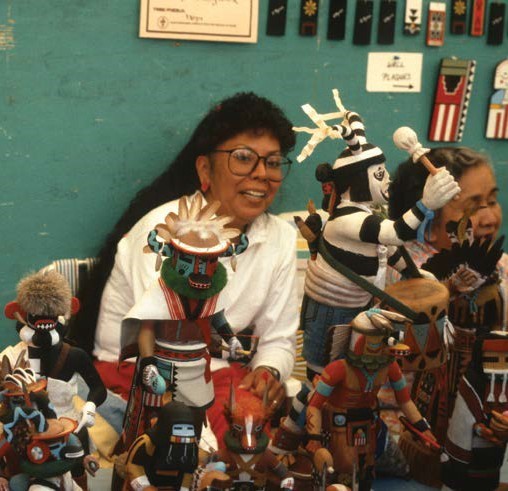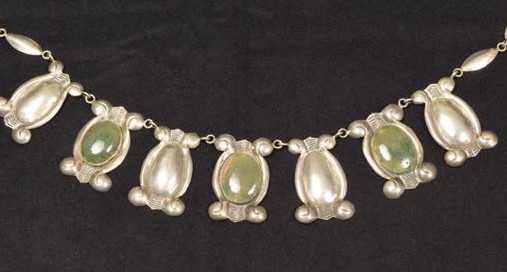History and Heritage: A Century of Indian Market
A century of Native American art is on view at the New Mexico History Museum through August 31, 2023.
Honoring Tradition and Innovation: 100 Years of Santa Fe’s Indian Market 1922-2022 features more than 200 works by Indian Market artists, celebrating the artists and collectors who have made Indian Market possible. “Santa Fe’s Indian Market was created to preserve and perpetuate the cultural heritage of Native Americans,” says Cathy Notarnicola, the museum’s curator of Southwest history.
Indian Market’s arc of creative endeavor is demonstrated in a chronological progression, beginning with the earliest works made for the inaugural 1922 Indian Market. The historic examples in the exhibition link Native art traditions to contemporary voices of today, demonstrating that neither are isolated in the past. Each is distinctively individual and continuously evolving. 
The show arrives at the present day showcasing works by Native artists who grew up straddling their traditional cultures and the popular culture of the modern world.
Viewers know they are entering new territory with the works of contemporary jewelers Charles Loloma (Hopi) and Denise Wallace (Chugach Aleut), who added novel materials like fossilized ivory, precious stones and rare woods to traditional jewelry.
Tony Da (San Ildefonso Pueblo), grandson of master potter Maria Martinez, innovated his pottery with sgraffito etching, inlaid stones and bands of heishi. His highly stylized iconography, as seen in Bear, from 1978, was inspired by ancient Mimbres pottery he studied at Western New Mexico University.
Native storytelling reaches its contemporary apex in the exhibition as various artists reinterpret Western comic books from Indigenous points of view. In Diego Romero’s 2003 bowl, Double Take, the Cochiti Pueblo artist honors his ancestors' methods, techniques and forms of coiling clay while incorporating comic book-inspired imagery to address Native social issues. Jason Garcia (Santa Clara Pueblo) also employs comic art. His 2008 print, Tewa Tales of Suspense #5: Behold… Po’pay!, re-fashions Superman as a towering Native superhero. “Comics are another way of creating and
teaching stories and traditions to a greater audience," Garcia says.
 Indian Market’s reach to tribes beyond the Southwest is demonstrated with works by such artists as Passamaquoddy basket maker Jeremy Frey. For this seventh-generation artist, baskets are a necessity in his small Mainefishing town. In 2011, his porcupine quill and sweetgrass basket was the first basket ever to win Indian Market’s Best of Show award.
Indian Market’s reach to tribes beyond the Southwest is demonstrated with works by such artists as Passamaquoddy basket maker Jeremy Frey. For this seventh-generation artist, baskets are a necessity in his small Mainefishing town. In 2011, his porcupine quill and sweetgrass basket was the first basket ever to win Indian Market’s Best of Show award.
“I’m helping put basketry on the map,” Fry says. “I try to do cutting-edge, but I don’t want to go far away from what my tribe has given me for an art form.”
The exhibition also emphasizes the importance of collectors in the century-long continuum of Indian Market. Thirty-three objects from the collection of JoAnn and Bob Balzer are on loan to the museum, showcasing their more than 50 years of Indian Market purchases.
“While all of our pieces are special, the most special is Jody Naranjo’s pot, Indian Market Daze,” says JoAnn Balzer. “It tells a story about Indian Market, with various Indian Market scenes all over. One is of Kathleen Wall, another is frybread, there is the Cathedral, the fashion show, the children. When we look at this pot, it reminds us of all our fond Indian Market memories.
New on View from the Collection
Silver and Stones: Collaborations in Southwest Jewelry, currently on display in the New Mexico History Museum’s Palace of the Governors, showcases for the first time ever an unusual jewelry collection from the 1940s and 1950s. The collection exemplifies the beneficial economic relationship between Diné (Navajo) silversmith David Taliman and merchant William C. Ilfeld. 
William C. Ilfeld was the grandson of the Jewish pioneer Charles Ilfeld, who emigrated to New Mexico from Germany in 1865.
William managed the Native American jewelry department at the family’s department store in Las Vegas. Taliman worked in several trading post shops, including Maisel’s in Albuquerque and Julius Gan’s Southwest Arts and Crafts in Santa Fe.
Ilfeld’s designs were produced by Taliman, who often used stones from Ilfeld’s personal collection. The necklace above is part of the jewelry collection donated by Ilfeld to the New Mexico History Museum in 1971.
Images: [Top] Eagle Dancers performing at Indian Market, Santa Fe, New Mexico, 1991. Courtesy Palace of the Governors Photo Archives, Neg. no. HP.2014.14.676. [Middle] Hopi Artist Elsie Talahytewa at Santa Fe Indian Market, Santa Fe, New Mexico, 1991. Photo © Annie Sahlin. Courtesy Palace of the Governors Photo Archives, Neg. no. HP.2013.12.081. [Bottom] Necklace by silversmith David Taliman, donated to the New Mexico History Museum by William C. Ilfeld. Photo courtesy New Mexico Department of
Cultural Affairs.
This article and images are from the Museum of New Mexico Foundation’s Member News Summer 2023.


Connect